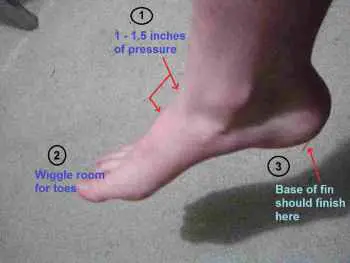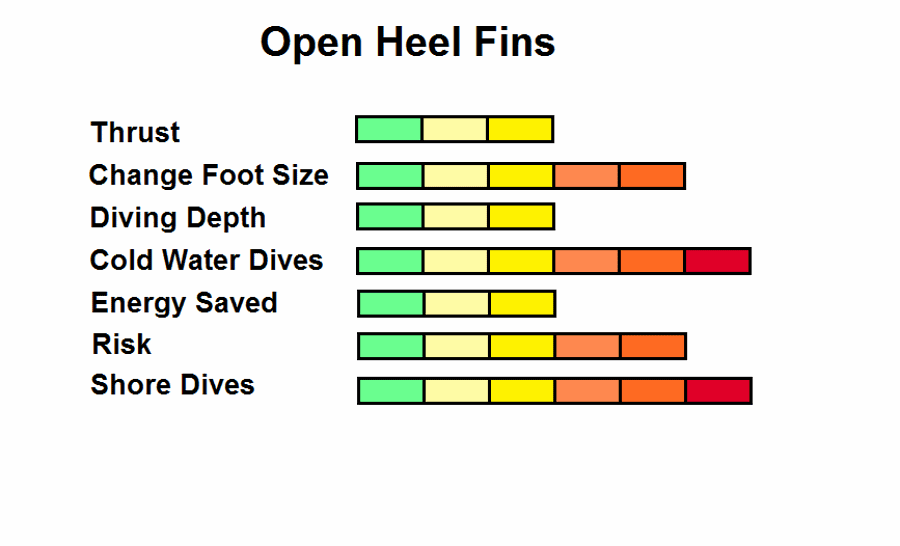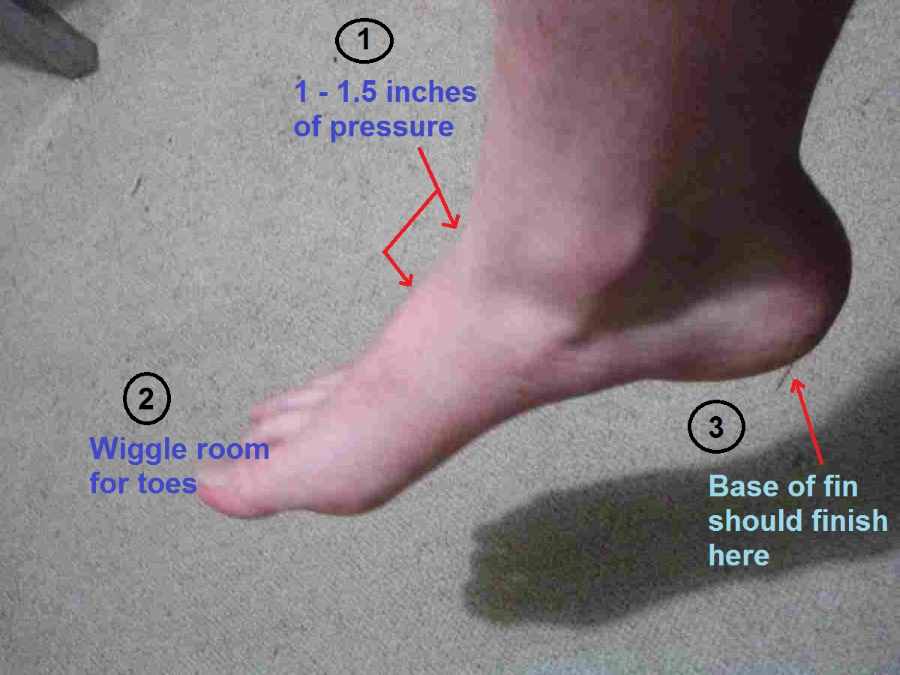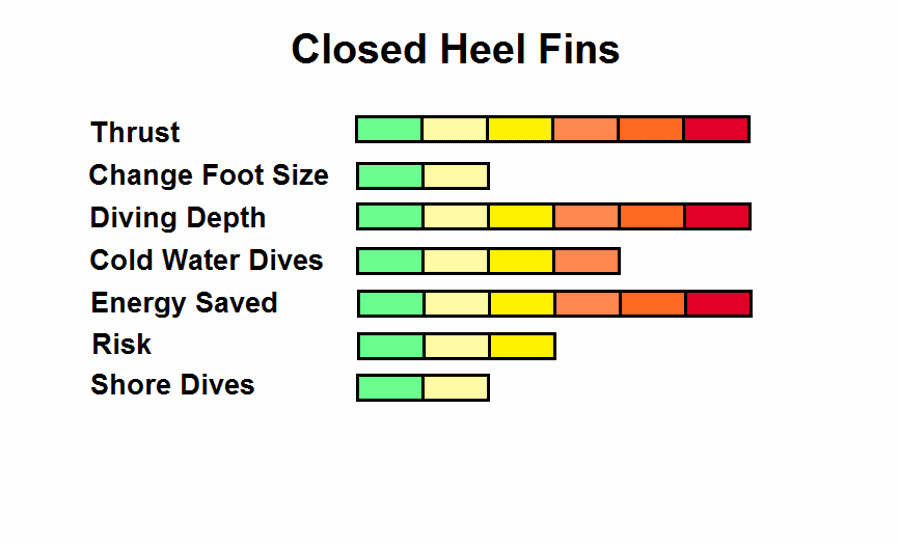- You are here:
- Home »
- Blog »
- Gear Guide »
- Freediving Fins: Open Heel vs Closed Heel Fins
Freediving Fins: Open Heel vs Closed Heel Fins

This is especially true if you’re new to freediving and overwhelmed with all the different information out there. In this post, I’m going to help you decide what fin heel to use for freediving.
Open heel or closed heel? Let’s find out.
Open heel freediving fins

Open heel fins are great for recreational divers.
Open-heel freediving fins wrap only partially around your feet. The front of your foot is completely enclosed while the back of your foot is secured by an adjustable strap. To the right you’ll see a diagram I made rating each feature of open heel fins. Below is an explanation of each score.
Thrust (score = 3/6): Open heel freediving fins do not fully enclose around your feet. So when you kick, there is much weaker power transference. Much of the power is lost as the fin isn’t tightly wrapped around the back arches of your foot. This results in a less efficient kick and slower speed through the water.
Changeable Foot Size (score = 5/6): You should be able to easily use the adjustable straps to make up for small changes in foot sizes. For example use thick soled diving booties on some dives and use neoprene socks on other dives. Both are doable with the same foot pocket by using your adjustable strap carefully. Please note adjustable straps will not let people with complete opposite foot sizes share the same fins.
Diving Depth (score = 3/6): Open heeled fins are less efficient and less powerful. This means your kicks are basically ‘handicapped’ so you have to do more kicks to cover the same distance. Overall, you’ll sacrifice diving depth.
Cold Water Dives (score = 6/6): If you’re diving in cold water and don’t want your toes to freeze off…you can slip on some thick, warm freediving boots (I recommend these ones here) – and the best part is that thick boots fit nicely into open-heel foot pockets because they have size adjustable straps.
Also, if you’re diving in cold waters you may want to get a freediving hood (like this one here) and some nice thick gloves to keep you warm during your dive.
Energy Saved (score = 3/6): Less efficient kicks means more energy is drained from your body as you move through the water. Less energy, is less oxygen. And as you know, in freediving, oxygen is everything.
Risk (score = 5/6): The risk here is twofold: First, you’re using fins which have a handicapped kicking power. When you’re underwater and seconds away from blacking out, do you really want to rely on fins with weaker thrust?
Another risk of open heel fins is the buckle from your adjustable strap could get tangled in something. It’s fairly common for the straps to get caught up in nets, weeds or your float line after duck diving (the last one is more common than you’d think!). You also have the chance the strap malfunctions and you lose the fin when diving (dangerous if you’re about to start your ascent!).
Shore Dives (score = 6/6): The adjustable straps let you make room for thick-soled diving booties. This is fantastic if you’re a shore diver and need to walk long distances over rocks, barnacles or shells. Your thick soled booties won’t tear unlike thin neoprene socks common to closed heel fins.
Open heel fins: socks, boots or barefoot?
Generally you’ll want to use diving booties or at the very least some nice neoprene socks.
Try not to use open heels barefooted. Not only will you lose heat quickly, you’ll also end up with some pretty painful blisters!
How should open heel freediving fins fit?

Please excuse my big ugly foot!
1) You want the fin to be secured tightly. You should feel some pressure just in front of the area on the top of your foot where your leg connects (in line with your knee). This pressure should continue down for about 1 – 1.5 inches toward your toes.
2) Your toes should feel nice and loose. They should be able to wiggle around a little. Your toes should not be pressed up against the sides of the fin.
3) The back of the fin should come up to about halfway the ball of your foot. If the fin ends before the ball of your foot you’ll lose kicking power.
Who should wear open-heeled fins?
If you’re doing casual water sports like scuba, snorkeling or body boarding with a little recreational freediving on the side, go for open-heel fins. You’ll find open-heels are used more as jack-of all-trades.
They give extra thrust when compared to no fins, but aren’t meant for elite, deep dives. This is exactly why it’s so rare to find high quality long-bladed freediving fins with open heels. Most long freediving fins have fully enclosed foot pockets so they don’t lose any thrust whatsoever which is common to open heels.
If you’re wondering what the best closed heel freediving fin for optimal underwater speed is, check out this post I’ve written here.
Lastly, if you’re a shore diver and wear diving boots; you may want to buy open-heeled fins. You’ll easily be able to adjust the foot pocket to fit your thick soled booties. Just remember that you’re leaving extra kicking power on the table with open heels.
Closed heel freediving fins

Closed heel fins transfer much more power, leading to greater speed.
Closed-heel or full foot pockets wrap all the way around your foot and heel.
Thrust (score = 6/6): Fully enclosed foot pockets make for incredibly efficient kicking with tremendous power transfer per kick. End result? Closed heels give you that extra boost so you slice through water like a human torpedo. Combined with long fin blades, a high-quality low-volume freediving mask and the correct weight belt for freediving…and you’ll be devastatingly agile in the water.
Changeable Foot Size (score = 2/6): Closed heel fins wrap all the way around your feet leaving no real room for adjusting. There’s no supporting strap or buckle to tighten the fin. The size you buy is exactly what you get, so make sure you choose the right size. Best way to do this is to use the stores’ size chart and be sure they do returns.
Diving Depth (score = 6/6): Your fully enclosed foot pocket makes for full power transference so you rocket down to undiscovered depths.
Cold Water Dives (score = 4/6): In cold water wear thick neoprene (3 – 5mm) socks to keep your feet warm. Make sure the socks aren’t too thick. If you wear thick socks and dive very deep, your socks compress. When this happens your fins fit looser leading to less thrust. Also, your thick sock could even shrink so much that you lose the entire fin in very deep dives which is dangerous. If you’re worried about that I recommend using fin keepers to secure your fins tightly and stop them falling off.
Energy Saved (score = 6/6): You’re kicking with incredible efficiency. Each kick propels you smoothly through the water. No power is lost as you glide to your target distance without sapping energy reserves from your muscles.
Risk (score = 3/6): As far risk goes with closed heel fins falling off; it’s incredibly rare (unless you’re wearing thick socks as mentioned above). Your main risk here could be accidentally cutting your rubber foot pocket on some coral or debris and then losing the fin when diving. To stop this, wear high quality diving fins with sturdy foot pockets. Never leave your fins laying in the sun. If the foot pockets get too dry from the sun they may crack and tear.
Shore Dives (score = 2/6): Shore dives usually involve wearing thick-soled booties so you don’t hurt your feet walking over jagged rocks and other painful materials. But the problem is that diving booties don’t fit into closed heel foot pockets. And you don’t want to walk over rocks in your diving socks as they’ll tear.
So if you insist on wearing boots before diving…walk to the shore, get in the ocean, take your boots off and then slip on your fins. Then before you dive, tie your boots to your diving buoy in a bag or with rope.
How should closed-heel freediving fins fit?
You want to feel tightness and looseness in the same areas as with open heel fins (pictured above in the open heels section). To summarize:
1) You want tightness where your foot connects with your leg (1 – 1.5 inches of pressure).
2) Enough room for your toes to wiggle around comfortably.
3) Tightness around the heel.
To test whether your fin is too tight or too loose: poke a pen in between your foot and the side of your foot pocket. It should fit fairly tightly and shouldn’t wiggle around if you take a step.
Closed heel fins: socks, boots or barefoot?
Best choice is to go with some thin neoprene socks. They keep your feet warm, make the foot pocket more comfortable and prevent blisters.
If you don’t have the budget; go barefoot.
And remember – don’t wear diving booties in closed heel fins. They’ll fit awkwardly and you’ll lose power. Or you’ll stretch and tear the foot pockets (which are expensive to repair/re-buy!).
Who should wear closed-heel fins?
Closed heel fins are for freedivers and spearfishers. They let you blast down to the bottom, and jet back up as efficiently as possible. The boosted efficiency of each kick means you use a slow and smooth kicking technique which saves oxygen and lets you dive deeper for longer.
Another reason closed heel fins are better for freedivers, is they often come with long blades. This is a huge benefit as long-bladed fins unlock way more power per kick. They are miles more efficient than short freediving fins.
Lastly, closed-heel fins also very often have removable blades. So if you’re a beginner freediver currently using cheap plastic blades…but looking to move up to fibreglass or carbon fibre months down the track; go with closed heel fins.
When you save up more money and are ready to invest in better blades; you’ll easily be able to swap it out for a better one…without having to pay the full price of an entirely new footpocket/fin.
If you’re looking for a high-quality, entry-level freediving fin that’s both packed with power and beginner-friendly; I recommend investing in The Gara Professional LD Cressi Fins – Click here to check the price on Amazon.
Is there a closed heel or open heel size chart?
If you buy your fins online, use the store’s size chart. Try not to use random charts if they are unrelated to the online freediving store you’re buying from. The reason for this is because random size charts can be specific to a single diving brand’s fin style (for example Cressi). They could also be specific to that particular website’s fin only.
Whereas if you buy your fins based on a store’s size chart that you’re actually buying from…and the fin ends up not fitting, you can always explain the issue and swap/return the fin. (that is if they have a return policy – most good freediving stores do).
If you really need a ‘size’ to go with, use this rule:
Open heel fin size = your shoe size + 1. This compensates for thick-soled booties. Keep in mind you can adjust the size using the strap as well. Just make sure you don’t need to do too much adjusting. There’s only so much size error a strap can help with.
Closed heel fin size = your shoe size. You shouldn’t be wearing diving booties so the foot pocket should mold nicely around your feet as is. Remember to wear thin diving socks!
Open heel vs closed heel fins: which one is better?
For freediving & spearfishing: closed heel fins win this debate hands down.
For scuba, snorkelling, body boarding etc: get yourself a pair of open heel fins for more casual water sports.
About the Author Gerrie van Niekerk - Apnealogy
Gerrie is a passionate Freediver, Spearfisher, Digital Marketer, and author for the Apnealogy website. Gerrie is an SSI Level 1 certified Freediver who loves geeking out about freediving and spearfishing gear and lives for his family and adventure.


